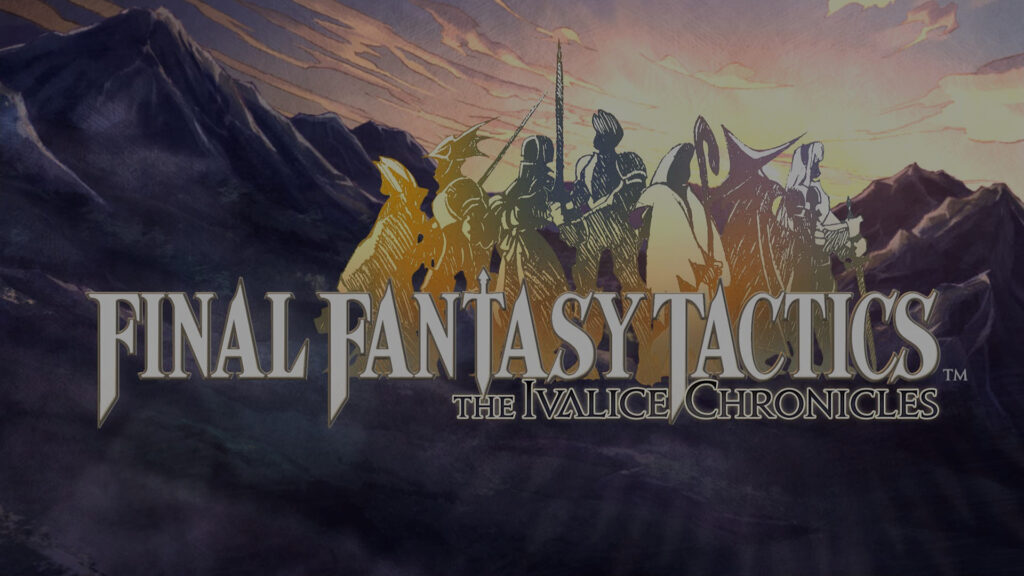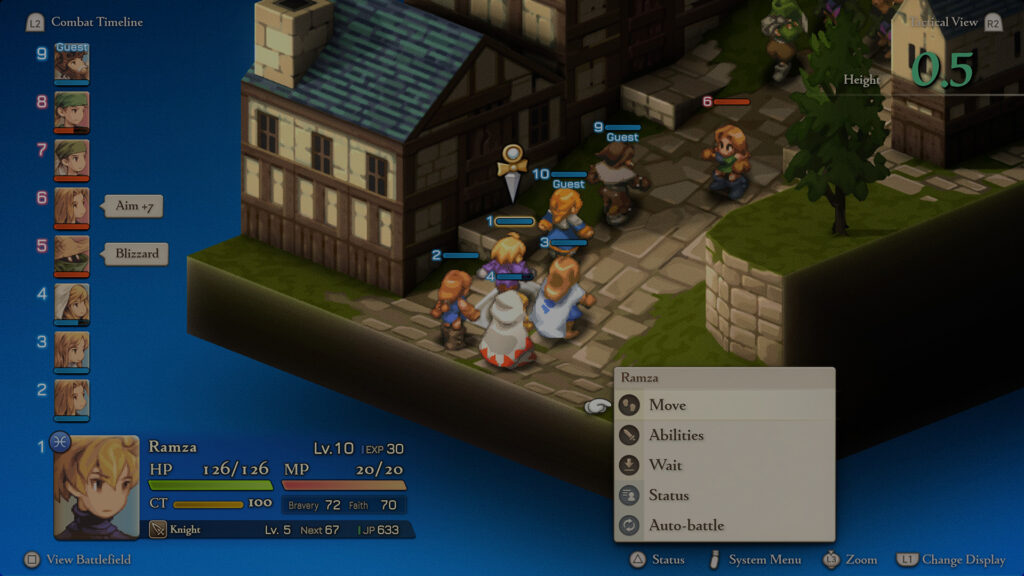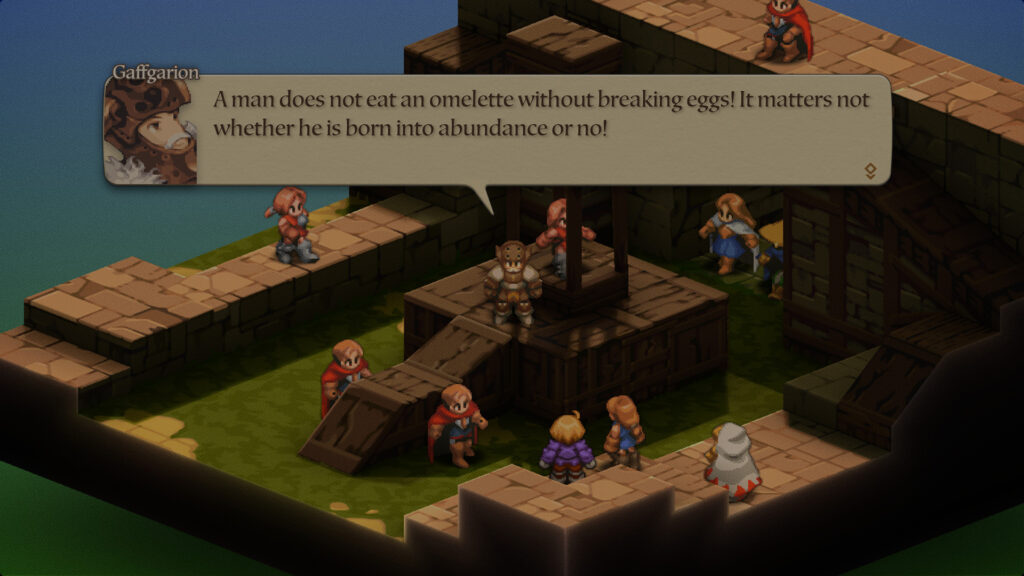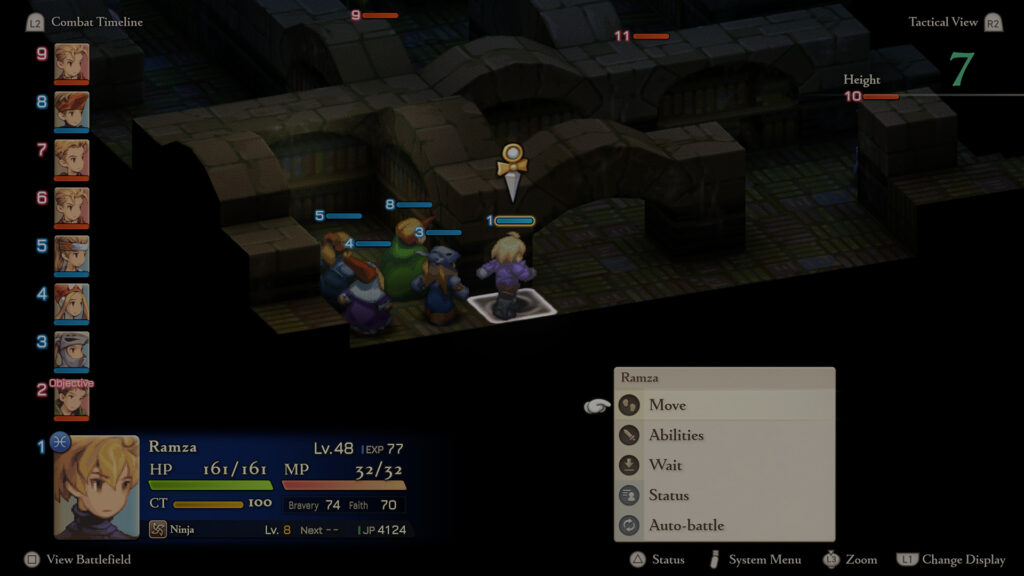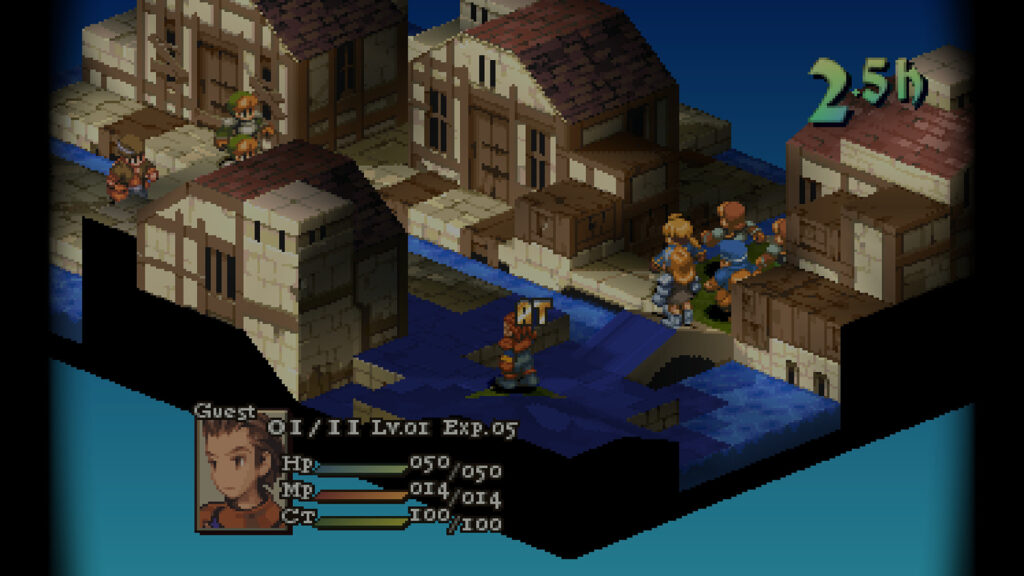Quick Verdict
It would be so easy to just call Final Fantasy Tactics a “timeless classic,” a phrase that’s frequently used in all forms of media. In truth, Final Fantasy Tactics – The Ivalice Chronicles proves that statement, preserving the core and spirit of a game designed in the mid-1990s with severe limitations compared to today. While not every little bit of the game has aged well, the fact that it remains intact and still delivers one of 2025’s best gaming experiences speaks volumes about how brilliant Final Fantasy Tactics really is.
Those who have played the original and want to relive the experience need only know that Creative Studio III has done it justice with Final Fantasy Tactics – The Ivalice Chronicles. While content from The War of the Lions is missing, the updated script, new voice acting, and all the quality-of-life improvements deliver a modern experience without ruining anything that made Final Fantasy Tactics so special. In short, this is the best way to experience Ramza and Delita’s story, and it’s very much worth a playthrough even if you know the entire game inside and out. If you’re new, though, there’s a lot more to cover than a Quick Verdict can provide.
Alma Mater

Originally released in Japan in 1997, Final Fantasy Tactics made its way to North America in 1998. In the decades since, it has been fondly remembered as one of the best and most influential tactical RPGs ever created. For years, fans have been clamoring for a remaster or a remake, especially since the original hasn’t aged all that well. When rumors of a Final Fantasy Tactics Remaster appeared in the now-infamous NVIDIA leak from 2021, some fans didn’t want to get too hopeful. As more and more of the games on that list became a reality, though, we waited with bated breath for the announcement to come. It finally did in June during a State of Play, and the best news was that the wait wouldn’t be much longer, as Final Fantasy Tactics – The Ivalice Chronicles had a September 30 release date.
In this era of seemingly endless remasters and remakes, Square Enix’s Creative Studio III could have taken several different approaches to bringing Final Fantasy Tactics to a modern audience. Obviously, the title isn’t popular enough to warrant a remake in the style of Final Fantasy VII’s, but even in giving the game a fresh coat of visual paint, the team could have turned to Square Enix’s signature HD-2D style. Instead, it opted for a similar style found in Tactics Ogre Reborn from 2022. While this may sound strange, screenshots actually don’t do this art style justice, as it has a halftone effect that gives it a pixel-like appearance. I know it won’t be everyone’s cup of tea, but I found myself loving it the more I saw it. It’s a balance of classic and modern, and it looks great in 4K or on a smaller display, like the Steam Deck (where I played dozens of hours).
The new visuals are accompanied by a complete overhaul of the game’s UI that provides much more information during battle. Each character’s panel displays their zodiac sign, level, EXP, Bravery, Faith, HP, MP, CT, as well as the current class and its level, JP, and experience needed for the next level. Targeting a unit also confirms how much the action will do, whether it’s damage or a heal, as well as the percentage chance that the action will succeed. Players can also change the overhead display for each character in battle, showing either icons for their buffs and debuffs in a Final Fantasy XIV style, their name, or nothing at all. There’s also the ability to place markers on the battlefield and to zoom in and out ever so slightly. The biggest UI change is the new Combat Timeline on the left. It’s a much-needed addition, allowing players to better plan their turns by knowing whether a unit will move before a spell is cast. The turn order is also represented above the units themselves, helping you identify the upcoming threats.
The Lion King

While modern visuals are typically the main reason to remaster a game, sometimes developers take the opportunity to redesign a game’s more controversial mechanics. If you’ve played the original Final Fantasy Tactics, you’ll know there are a handful of those controversial mechanics in the game, some of which are arguably very outdated in 2025. These include the possibility of permanently losing characters (including named ones like Agrias Oaks), having gear permanently broken or stolen, and even soft-locking your game. In fact, Final Fantasy Tactics may well be the reason I learned to create multiple save files in any RPG—and why save-scumming became a thing. It could have been acceptable if the team decided to smooth some of these over, or even remove them from the game altogether.
The decision Creative Studio III made was a smart one, and, in my opinion, the right one. In order to keep the essence of the game intact, warts and all, it opted to add new difficulty modes instead of removing any of the controversial mechanics. This way, everyone can still experience Final Fantasy Tactics as it was meant to be played, even if that means permanently losing a character or the game’s strongest weapon. If the idea of reloading saves sounds tedious to you, there’s an easier difficulty available. The fact of the matter is, some of these pain points are part of why Final Fantasy Tactics is so beloved, as there are real consequences to your choices in battle. Often this means reloading and figuring out a new strategy, but thankfully The Ivalice Chronicles adds an autosave feature (including in the classic version), and it’s a generous one at that. Just keep in mind, you’ll still want to pay attention even if you think you’re just farming easy mobs for JP and EXP. Don’t ask me how I know, I definitely did not lose one of my units and a very powerful weapon.
Another major quality-of-life addition is the ability to flee from a random encounter when you’re traveling on the map. The original version of the game, and subsequently the classic version that’s included, forces you to deal with random encounters on the map. In The Ivalice Chronicles, players can choose to fight or flee when encountering them, which is a blessing when you’re just trying to navigate the map. Alternatively, you can now also force an encounter on any of the map nodes, which comes in handy when all you want to do is grind. If a battle isn’t going your way, you can pause to retry with the option of changing formation or simply return to the world map. These additions go a long way toward streamlining the experience without watering it down.
Monk See, Monk Do

The above matters not if this is your first time experiencing Final Fantasy Tactics. Instead, you’re probably more interested in gameplay. As a tactical, turn-based RPG, Final Fantasy Tactics revolves around deploying units onto a grid and positioning them for both offense and defense. Like other standout titles in the genre, there’s a lot of RNG involved as every attack or ability has a chance to succeed. Of course, some actions are a 100 percent chance and there are ways to ensure better odds, but there are also instances when you’ll miss a Raise on a unit four times in a row, or an enemy evades, dodges, and parries six attacks in a row. Depending on your tolerance for this, Final Fantasy Tactics – The Ivalice Chronicles can be a frustrating experience, particularly on Normal and Hard difficulties. It’s one of the reasons why many consider it a very grindy game, since it’s better to just outlevel the content and take advantage of overpowered builds to bully your way through the story.
If you’ve played any game from the XCOM series, Final Fantasy Tactics will feel familiar: over time you’ll start believing the percentages are a lie. It’s the same vibe as XCOM’s “95 percent miss” energy, but it’s perhaps more understandable now thanks to Baldur’s Gate 3’s popularity. Much of these games isn’t very different from rolling a d20 and coming up with a Nat 1 or Nat 20. Over time, it’s obviously statistically fine, but there are undoubtedly instances where a string of bad luck rears its head at the worst possible time. To give a real-world example, each time a unit dies, a countdown in the form of three hearts appears over its head. Essentially, you have three of that unit’s turns, which you can track on the timeline, to resurrect it. Otherwise, it’s lost forever. I had one fight where I failed four Raises in a row, despite a 74 percent chance each time. Swapping over to my Arithmetician job, that’s a 0.46 percent chance, roughly the same as pulling a featured banner character in your favorite gacha.
Many of the battlefields will have your units dealing with height and terrain, which can hinder movement or restrict attacks. Line of sight is important, and so is positioning when it comes to casting spells. Most spells and some skills are cast in a plus (+) formation, and you can heal enemies or hurt your allies if they happen to be on those tiles. This is where a lot of the strategy lies, especially with the addition of the Combat Timeline. Now that you can easily tell when a spell is being cast, you can do some very clever things. For example, your Black Mage may not be able to reach an enemy with a spell, but you can cast that damage spell on one of your units and move that unit within range of the enemy. When that spell is finally cast, it’ll also damage the enemy along with your friendly unit. The same goes for healing and buffing. You can also choose whether to cast a spell on a unit or a tile. Choose the unit, and the spell will be cast on it even if it moves out of range; choose the tile if you want it to always affect that specific location. It sounds basic in practice, but opens up lots of possibilities once you spend ample time within the system.
Faith Restored

Where Final Fantasy Tactics sets itself apart is with its intricate Job system. The game offers over 20 jobs, some unique to specific characters and some restricted by gender in the case of Bard and Dancer. Speaking of Bard and Dancer, since this uses the original release’s design, the Bard is restricted to male characters and has defense-minded skills, while the Dancer, for female characters, is offense-oriented. The most important thing to note here is that the coveted Movement+3 ability is restricted to Bard in The Ivalice Chronicles, while Dancer gets Jump+3. If any of that makes sense to you, it’s something to remember when constructing your team.
Final Fantasy fans will recognize many of these jobs, with traditional Thief, White Mage, Black Mage, Summoner, Archer, and more making an appearance. Each unit can be assigned a primary job, which locks in its job command, like Black Magicks for a Black Mage. Build customization comes into play when choosing a character’s Action, Reaction, Support, and Movement abilities (one each). The Action ability gives the character access to the active skills of a job, meaning the spells or abilities associated with it. They do not inherit any passives, such as the ability to dual-wield with Ninja. Instead, those are assigned to the other slots. Reaction abilities trigger on specific events, for example, automatically using a potion upon taking damage or increasing a unit’s speed for the rest of the battle after being hit. Support abilities range from increasing a unit’s magickal attack to throwing items or preventing equipment from being destroyed or stolen. Finally, Movement abilities will not only boost the number of tiles a unit can move per turn but can also let units traverse greater elevation differences (Jump) or even teleport around the map.
While there are over 20 jobs available in the game, each character only has access to 19. As mentioned before, many named characters that can join you on your journey (some optional from side quests) have unique jobs. Agrias Oaks, for example, replaces the Squire job with Holy Knight. As you can imagine, with all these different jobs and the skills associated with them, the amount of build variety is nearly endless. I’m sure someone has done the math on the possibilities, but you can create a Ninja who dual-wields axes, can heal and parry, and teleports all around the map. And that’s not even one of the crazier builds.
Deliteral Truth

Fully unlocking the potential of your characters is the main reason why you’ll spend time grinding in the game. Each character has a level that impacts overall stats, and each job has its own level as well. This mainly affects the ability to unlock other jobs, as some will have level requirements from multiple jobs. Unlocking abilities for each job requires earning job points (JP), which are granted for any action that has an effect. So yes, you can sit there in a corner hitting your own units and healing them in order to grind JP if that’s your thing. For most players, you won’t have to worry about grinding every single job. The vast majority of battles in the game have you deploying five units, and you’ll eventually find the specialties you want for each character. It’s a lot like the original Final Fantasy: if you want a party of all white mages, you’re free to do that. If you want to pretend you’re playing an MMORPG, get yourself a melee attacker, a ranged attacker, a healer, a buffer, and a caster.
While the original Final Fantasy Tactics did have an AI option for auto-attacking, The Ivalice Chronicles fine-tunes those selections and boils them down to: Attack Enemy, Protect Ally, Heal Allies, and Get to Safety. Setting auto-battle on a unit lets the AI take over, which means you can do a bit of farming without fully paying attention. Again, though, make sure you’re not fighting enemies that can destroy or steal gear. Otherwise, you’ll want to equip the Safeguard ability. I recommend checking in on your team and saving after every battle, so you don’t accidentally lose someone. Helping make the grind quicker is the new option to fast-forward combat. The bad news is you have to continually hold a button to do so, instead of it being a persistent setting. I’m not sure why Battle Speed isn’t available in the options, and it’s one of the odder misses among the quality-of-life additions.
The final aspect of character customization is equipment, and it’s pretty standard fare if you’ve played any RPG. Each character equips five items: one in each hand, headwear, combat garb, and an accessory. As expected, each piece of equipment has a list of eligible jobs, meaning not every job can equip a shield or a specific piece of headwear. There’s a good level of customization here, though, as some equipment offers attribute bonuses and effects, ranging from increased movement to attack power boosts to immunity to certain status effects. Some accessories are key to progressing, completely negating frustrating mechanics like Sleep and Doom. All in all, these systems work together to create one of the best uses of Final Fantasy’s famous job system and give the player tremendous freedom to build a party that’s uniquely theirs.
A Blade Between Brothers

Now, you can’t talk about Final Fantasy Tactics without touching on its story and iconic characters. It’s set during the War of the Lions and follows Ramza Beoulve and his childhood friend, Delita Heiral, as they’re pulled from schoolyard skirmishes into a complex political world embroiled in conspiracies, class resentment, and lies. In a way, the story carries a lot more weight when experienced today than it did 27 years ago, when it was first released. If you’ve watched Game of Thrones, you’ll appreciate just how well written Final Fantasy Tactics is, from its political intrigue to its backstabbing characters. It’s a grounded story with a clear message, and it’s more relevant than ever.
The addition of a stellar voice cast really takes the experience to an entirely new level. Every line of dialogue in this game is performed by an actor who delivers it with clear command of tone and scene. Final Fantasy Tactics – The Ivalice Chronicles is one of the best modern-day examples of how voice acting can bolster a game (Nintendo, take note), taking the story to new heights by making its complex language easier to understand. It’s the difference between reading a Shakespearean play and watching it unfold on a stage. It’s also great that we now know how to officially pronounce some of these names after all these years.
Creative Studio III also implemented a different version of its Active Time Lore feature from another one of its major titles, Final Fantasy XVI. The Chronicle can be found as a menu option and comprises an Encyclopedia, State of the Realm, Events, and more that I won’t mention to keep things spoiler-free. It’s essentially a detailed menu that provides information on characters, locations, terms, and more. The State of the Realm delivers an intuitive, visual way to understand what’s going on in the story, while the Events tab provides more detail on pivotal moments in the game’s history. Those who love lore and learning more about the world of Ivalice can spend hours on these screens, and this feature really shouldn’t be overlooked.
Beoulve It or Not

Along with the main story, the game’s map features distractions that can pull you off the main path. In addition to side quests that mainly open in the game’s final chapter, there are shops and taverns to visit in every major city. Annoyingly, some equipment is sold only at specific shops, which means visiting multiple locations on the map when a new tier becomes available. However, this goes hand in hand with tavern errands, which let you send out reserve units to complete tasks. There isn’t much to this beyond choosing which units to send out (they won’t be available in combat while on an errand) and how many days to keep them occupied. Generally, you’ll want to set it to the maximum number of days for the best chance of success. These activities normally return Gil and earn JP for the units. It’s a nice way to passively grind JP for your backup units, but it really isn’t that important. Still, they’re worth undertaking for passive income, although you’ll easily grind millions of Gil while leveling jobs. There are some special collectibles from tavern errands, but they’re basically Easter eggs for Final Fantasy fans.
As for reserve units, your party roster can consist of up to 50 characters. Until you’re able to recruit some of the named characters with unique jobs, your party consists of generic characters that you can rename and recruit from each main city. For the most part, you won’t find much use for backup units beyond your core party, but there are sequences toward the end of the game that involve multiple consecutive fights. Here, you may want access to a mix, but you’ll also be able to reassign jobs between those fights. In other words, you’ll stockpile backup units mainly to send them out on tavern missions and stick to using your core group for battle.
You can also incorporate chocobos into your battle party, although it feels more like a novelty than a necessity. The biggest benefit is the ability to ride them in combat, but sacrificing a well-built unit for the slot is rarely worth it. The game forces you through a tutorial on recruiting your first chocobo, aptly named Boco, and once you have at least one, eggs will occasionally appear in your party after finishing random battles. Advancing one day on the map will cause that egg to hatch into another chocobo, and before you know it, half your party will be full of them. I found myself releasing many of them from time to time, since the party is capped at 50 units.
Tietra Firma

On PC and Steam Deck, Final Fantasy Tactics – The Ivalice Chronicles ran flawlessly. I didn’t encounter any bugs or crashes, though the game is capped at 60 FPS. Fortunately, that doesn’t matter too much for a title like this. If you’re not interested in the modern sensibilities that have been added, you can play the original Final Fantasy Tactics as part of the bundle, with the addition of autosave to keep you from soft-locking your game. Since that version of the game is inherently different from The Ivalice Chronicles, it’s a separate save, and you can’t transfer progress between the two. So unlike other remasters, there’s no one-button toggle for classic and modern graphics. They’re essentially two different games.
Finally, I have to mention the game’s soundtrack. Once again, the music is the star with familiar themes feeling fuller, cleaner, and more present. Combined with the voice acting, the audio experience helped carry more than its share of storytelling weight. Completing the game grants you access to a Music Player with a full soundtrack, quite possibly the best reward you can get for rolling credits. Oh yeah, and you get all this for just $49.99, a price Square Enix deserves credit for.
There was a brief moment during the opening sequence of Final Fantasy Tactics – The Ivalice Chronicles where I sat there in awe, thinking to myself, I can’t believe this is happening. It was a different feeling from Final Fantasy VII Remake, since The Ivalice Chronicles preserves the very essence of Final Fantasy Tactics. It’s that impression you get where you look at the game and think, “This is how you thought it looked the first time you played it.” After spending a little over 50 hours finishing the main story, I’m now venturing through Midlight’s Deep because I just can’t get enough of this game. Final Fantasy Tactics – The Ivalice Chronicles doesn’t apologize for its age, and it shows you how to live with it. And for that, I’m grateful because, for once, the words “timeless classic” actually apply.
Final Fantasy Tactics – The Ivalice Chronicles has an official release date of September 30, 2025, for PlayStation 4, PlayStation 5, Xbox Series X|S, Switch, Switch 2, and PC. This review is based on a retail code provided by Square Enix on PC. The Final Fantasy Tactics – The Ivalice Chronicles Collectors Box seen in the photo was purchased. While FullCleared has affiliate partnerships, these do not influence our editorial content. We may, however, earn commissions for products purchased via affiliate links.


